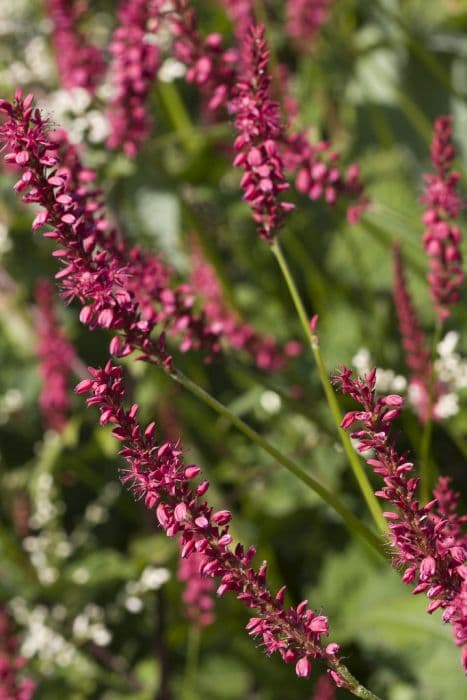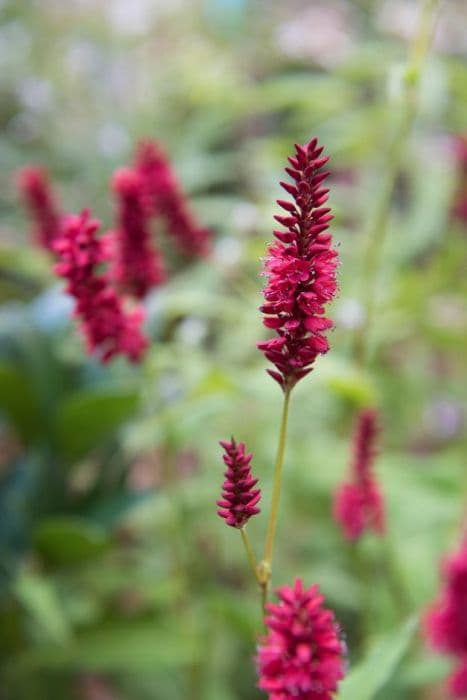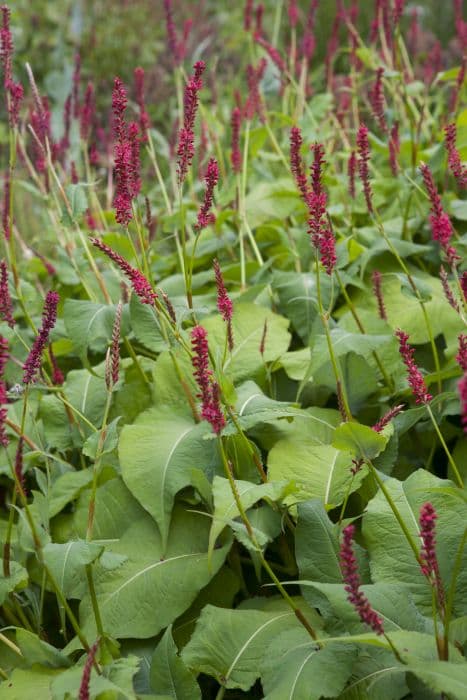Alpine knotweed Persicaria vacciniifolia

ABOUT
Persicaria vacciniifolia, commonly known as alpine bistort, is a plant that features a lush carpet of green leaves. The foliage has an oval shape and a pointed tip, which often resembles miniature lily pads. The leaves are arranged in a dense, ground-covering mat, providing a rich backdrop for the flowers. These leaves sometimes show off a bronze tint, especially when the temperatures are cooler, which adds a touch of color to the dense greenery. The flowers of the alpine bistort emerge above the leaves on slender, wiry stems. They are small, pink, and clustered into elongated, narrow spikes resembling tiny bottle brushes or soft caterpillars. These attractive blooms add a delicate, airy feel to the plant's appearance and can last quite a while, gracing the foliage from late spring into the summer, and sometimes even into the fall. Alpine bistort is known for its resilience and can provide a charming ground cover in many garden settings thanks to its creeping nature. It is a plant that's often appreciated for its ability to fill spaces with its delightful foliage and charming blooms, bringing a splash of color to the garden with minimal maintenance.
About this plant
 Names
NamesFamily
Polygonaceae.
Synonyms
Red Barrenwort, Jointweed.
Common names
Polygonum vacciniifolium, Bistorta vacciniifolia.
 Toxicity
ToxicityTo humans
Alpine knotweed is generally not considered to be toxic to humans. There is limited information available on its toxicity, indicating that it does not typically pose a risk if accidentally ingested. As with any plant, individual sensitivities can vary, so it's always prudent to avoid eating any plant material you are not familiar with. If Alpine knotweed is ingested and adverse symptoms appear, medical attention should be sought.
To pets
Alpine knotweed is not commonly listed as toxic to pets. However, as with humans, individual animals may have different sensitivities, and it's always best to keep an eye on your pets and prevent them from ingesting plants that are not intended for consumption. If your pet does eat Alpine knotweed and begins to show symptoms of discomfort or illness, consult a veterinarian.
 Characteristics
CharacteristicsLife cycle
Perennials
Foliage type
Deciduous
Color of leaves
Green
Flower color
Pink
Height
1-2 feet (30-60 cm)
Spread
1-2 feet (30-60 cm)
Plant type
Herb
Hardiness zones
5
Native area
Asia
Benefits
 General Benefits
General Benefits- Ground Cover: Persicaria vacciniifolia, commonly known as American cranberry bush, can spread efficiently to cover bare soil, helping to reduce weed growth and soil erosion.
- Garden Aesthetics: This plant offers ornamental value with its dense mats of green foliage and attractive pink or white flower spikes, enhancing the visual appeal of gardens and landscapes.
- Attracts Wildlife: American cranberry bush can attract pollinators like bees and butterflies to the garden, which play a crucial role in plant reproduction and ecosystem health.
- Drought Tolerance: Once established, Persicaria vacciniifolia has good drought tolerance, requiring less water and making it suitable for low-maintenance or xeriscape gardens.
- Soil Enrichment: By covering the soil, this plant helps to maintain soil moisture and can contribute to the overall soil health over time.
- Seasonal Interest: The plant provides seasonal interest with its changing foliage colors from green in spring and summer to reddish hues in fall, complementing the seasonal dynamics of a garden.
- Low Maintenance: American cranberry bush requires minimal care once established, making it a practical choice for gardeners of all skill levels.
- Fast Growth: It grows relatively quickly, which can be advantageous for gardeners looking to establish ground cover or fill space in a short amount of time.
 Medical Properties
Medical PropertiesThis plant is not used for medical purposes.
 Air-purifying Qualities
Air-purifying QualitiesThis plant is not specifically known for air purifying qualities.
 Other Uses
Other Uses- American Alpine Speedwell can be used as a green roof planting since it is tolerant to tough growing conditions and helps in insulation and stormwater retention.
- It serves as an ideal ground cover for rock gardens or alpine gardens, offering aesthetic beauty and suppressing weed growth.
- This plant is used in butterfly gardens as it attracts various butterflies and beneficial insects, promoting biodiversity.
- The dense mat of American Alpine Speedwell can be utilized for erosion control on slopes or banks, stabilizing soil with its root system.
- It is suitable for container gardening, bringing lush foliage and a splash of color to balconies or patios.
- American Alpine Speedwell can be used in crafting and flower arrangements, particularly in creating natural, wild-looking compositions.
- It serves as a living mulch, keeping soil moist and cool, thus reducing the need for frequent watering and maintenance.
- The plant can be used in sensory gardens due to its textured foliage which provides a varied tactile experience.
- In landscape design, American Alpine Speedwell can be used to create a tapestry effect when planted in combination with other low-growing species.
- Its dense foliage can be employed as a lawn alternative in areas with light foot traffic, reducing the need for mowing and lawn care.
Interesting Facts
 Feng Shui
Feng ShuiThe Persicaria vacciniifolia is not used in Feng Shui practice.
 Zodiac Sign Compitability
Zodiac Sign CompitabilityThe Persicaria vacciniifolia is not used in astrology practice.
 Plant Symbolism
Plant Symbolism- Resilience: Persicaria vacciniifolia, also known as Alpine Bistort, is a plant that thrives in harsh alpine climates, symbolizing the ability to withstand challenging conditions and maintain vitality.
- Adaptability: The Alpine Bistort demonstrates significant adaptability by growing in a variety of soil types and conditions, representing flexibility and the ability to thrive in diverse environments.
- Persistence: This plant grows persistently and can spread across areas over time, representing determination and an enduring spirit.
- Grounding: As a plant that spreads along the ground, Alpine Bistort may symbolize staying grounded and connected to one's roots or foundation.
 Water
WaterFor Alpine knotweed, water the plant deeply at planting to ensure proper establishment and then reduce watering to when the top inch of soil dries out, typically watering once a week. During hotter seasons, water the plant every few days, ensuring that the soil remains moist but not waterlogged. It requires approximately 1 gallon of water per week for a medium-sized plant, adjusting the amount depending on weather conditions and soil moisture levels. Over-watering can lead to root rot, so ensure proper drainage.
 Light
LightAlpine knotweed thrives best in full sun to partial shade, meaning it prefers at least 4-6 hours of direct sunlight daily. The ideal spot for this plant would be in an area that receives morning sunlight and partial shade in the afternoon to protect it from the intense heat of the day.
 Temperature
TemperatureAlpine knotweed is hardy and can tolerate a broad range of temperatures, typically from 20°F to 80°F. It can survive brief dips below this range, but long-term exposure to temperatures below 20°F may harm the plant. The ideal temperature conditions for Alpine knotweed are between 60°F and 70°F, where the plant shows optimal growth.
 Pruning
PruningAlpine knotweed benefits from occasional pruning to remove dead or damaged stems and to encourage bushier growth. Prune in late winter or early spring before new growth begins. Cutting the plant back by about a third each year can maintain a compact and healthy shape. Pruning is typically done on an as-needed basis rather than on a strict schedule.
 Cleaning
CleaningAs needed
 Soil
SoilThe optimal soil mix for the Alpine Water Knotweed should be well-drained with a loamy texture, containing a balance of soil, sand, and organic matter. It prefers a slightly acidic to neutral pH, ranging from 5.5 to 7.0.
 Repotting
RepottingAlpine Water Knotweed typically doesn't need frequent repotting; it can be done every 2-3 years, or when the plant outgrows its container, to refresh the soil and provide more space for growth.
 Humidity & Misting
Humidity & MistingAlpine Water Knotweed thrives in moderate humidity levels, but it is quite adaptable and can tolerate a range of humidity conditions typical of a garden environment.
 Suitable locations
Suitable locationsIndoor
Provide bright light, moderate water, and good air circulation.
Outdoor
Plant in partial shade, rich soil, and space for spreading.
Hardiness zone
4-8 USDA
 Life cycle
Life cyclePersicaria vacciniifolia, commonly known as Alpine Knotweed, begins its life cycle as a seed that germinates in moist, well-draining soil in the spring. Emerging seedlings develop into vegetative plants with lance-shaped leaves and stems that may start to root at the nodes, spreading out to form a mat-like ground cover. During the summer, the plant reaches its reproductive stage, producing small pinkish or white flowers that attract pollinators and subsequently develop into fruit. After pollination, the fruits mature and release seeds that can disperse to new locations, where they can germinate to start a new generation. Throughout the growing season, Alpine Knotweed can also propagate vegetatively through its rhizomes, enabling the plant to expand its presence in an area. As a perennial, Alpine Knotweed dies back to its roots in the winter and reemerges from these same roots in the following spring, continuing its life cycle.
 Propogation
PropogationPropogation time
Spring to Summer
Propogation: Persicaria vacciniifolia, commonly known as Alpine Bistort, is often propagated through division, preferably in spring. To propagate Alpine Bistort via division, carefully dig up an established plant and gently separate it into smaller sections, ensuring that each new section has a portion of root and several shoots. These sections are then replanted in the ground or in pots filled with a mix of soil and organic material, such as compost, to encourage growth. Thorough watering after planting is crucial, but it's essential to ensure the soil isn't waterlogged to prevent root rot. This method is quite straightforward and helps to create healthy, vigorous offspring that will typically flower the same year if divided early enough.









